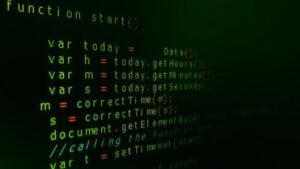Deepfake Software: Free and Powerful
The rise of deepfake technology has sparked both fascination and concern as it becomes more accessible to the general public. Deepfake software, with its ability to manipulate and alter videos, has raised ethical questions and potential misuse. However, it is important to understand the capabilities and implications of this technology. In this article, we explore the world of deepfake software, its key features, and its impact on various industries.
Key Takeaways:
- Deepfake software allows for the creation of highly realistic fake videos.
- It has potential applications in entertainment, marketing, and education.
- The technology raises concerns about misinformation and privacy.
- Regulation and detection systems are being developed to combat deepfake misuse.
The Power of Deepfake Software
Deepfake software utilizes artificial intelligence algorithms and machine learning techniques to create fake videos that are incredibly realistic. These tools can seamlessly swap faces, alter speech, and manipulate expressions, enabling creators to produce convincing and often misleading content.
Imagine being able to make anyone appear to say anything you want, even if they never said it.
Applications in Various Industries
The technology behind deepfake software has created new possibilities in multiple industries. Let’s explore some of the major applications:
- Entertainment Industry: Deepfake software has the potential to revolutionize filmmaking by allowing directors to bring deceased actors back to the screen or seamlessly insert actors into historical events.
- Marketing and Advertising: Brands can now create personalized ads featuring famous personalities, enhancing their marketing campaigns and reaching wider audiences.
- Education and Training: Deepfake technology can be used to create interactive training materials, simulate real-life scenarios, and enhance online learning experiences.
The Dark Side of Deepfake
While deepfake software offers exciting possibilities, it also raises significant concerns. Misuse of this technology can lead to the spread of fake news, blackmail, and even identity theft. Here are some key risks:
- Disinformation: Deepfake videos can be used to spread false information and manipulate public opinion.
- Privacy Invasion: Individuals may find their faces used without consent in deepfake videos, threatening their privacy and reputation.
- Online Harassment: Deepfake technology can be exploited to create explicit or defamatory content, leading to cyberbullying and harassment.
Regulation and Detection
To address the challenges associated with deepfake software, efforts are being made to establish regulations and develop detection systems. Governments and tech companies are investing in research and collaborations to combat the potential misuse of this technology. Detection algorithms are being refined to identify deepfake content, enabling quick action to contain its impact.
| Industry | Misuse |
|---|---|
| Politics | Creating fake speeches and interviews to manipulate voter opinions |
| Entertainment | Spreading fake celebrity scandals and controversies |
| Journalism | Producing fabricated interviews and news segments |
Combating Deepfake Misuse
In response to the misuse potential of deepfake software, various methods are being implemented:
- Legislation and Regulation: Governments worldwide are considering laws that govern the creation and dissemination of deepfake content.
- User Awareness and Education: Raising awareness about deepfake technology and its implications can help individuals identify and critically assess manipulated content.
- Collaboration Between Platforms: Tech companies are working together to develop tools and algorithms for detecting and removing deepfake content from their platforms.
| Technique | Advantages |
|---|---|
| Face Recognition | Highly accurate in identifying manipulated faces |
| Audio Analysis | Helps detect voice manipulation or synthetic speech |
| Artificial Intelligence | Machine learning algorithms can learn and detect patterns in deepfake videos |
The Future of Deepfake Software
As deepfake software continues to evolve and improve, it is crucial to stay vigilant and proactive in addressing the challenges it presents. Combining technological advancements, regulation, and user education will contribute to minimizing the negative impact of deepfake technology.
Deepfake software is a double-edged sword that can advance entertainment and communication industries, but also pose serious risks to individuals and society.

Common Misconceptions
Misconception 1: Deepfake Software is Only Used for Malicious Purposes
One common misconception surrounding deepfake software is that it is solely used for malicious purposes, such as spreading fake news or creating non-consensual explicit material. While it is true that there are instances of misuse, deepfake technology has potential applications in various fields.
- Deepfake software can be utilized in the entertainment industry to create realistic special effects and enhance CGI in movies.
- In the field of research, deepfakes can be used to generate synthetic data that simulates real-world situations, enabling scientists to conduct experiments and simulations without physical constraints.
- Deepfake technology has the potential to advance the medical field by creating accurate representations of patients’ organs for training purposes or developing new therapies.
Misconception 2: All Deepfakes Are Easily Detectable
Another misconception is that all deepfakes are easily detectable by both humans and artificial intelligence systems. While detection methods have improved over time, deepfake technology continues to progress as well, making it more challenging to identify manipulated content.
- New techniques, such as adversarial training, make it increasingly difficult for AI systems to distinguish between real and fake content. This creates a cat-and-mouse game between developers of deepfake software and detection algorithms.
- Deepfakes can deceive human viewers, especially when shared on social media platforms where critical scrutiny may be lacking.
- The rapid advancement of deepfake technology suggests that it is crucial to continue developing and improving detection methods to stay ahead of the deceptive use of this software.
Misconception 3: Deepfake Software is Accessible Only to Professionals
Many people assume that deepfake software is exclusively available to professionals with advanced programming skills and access to sophisticated tools. However, this misconception overlooks the increasing accessibility of deepfake technology.
- There are user-friendly deepfake apps and software available that require minimal technical knowledge, enabling ordinary individuals to create manipulated videos.
- Online tutorials and communities provide step-by-step guides and support for those interested in experimenting with deepfakes.
- The widespread availability of powerful personal computers and high-quality smartphones further enables individuals to engage with deepfake technology.
Misconception 4: Deepfakes Are Always Perfectly Convincing
Some believe that all deepfakes are flawless replicas that are impossible to discern from real footage. However, perfect deepfakes that are indistinguishable from reality are not yet the norm.
- Even though deepfake technology has advanced significantly, certain visual artifacts or inconsistencies can still give away manipulated content, especially to trained experts.
- Facial expressions and movements may appear unnatural or slightly distorted in some deepfakes, particularly when applied to complex interactions or actions that deviate from the training data.
- While deepfakes can be convincing to the untrained eye, technological advancements in detection methods and awareness among users have made it more challenging for deceptive actors to pass off their creations as genuine.
Misconception 5: Deepfakes Will Become the Ultimate Source of Misinformation and Harm
There is a common misconception that deepfakes will completely destabilize trust in media and become the ultimate source of misinformation and harm. While the potential for misuse exists, it is important to consider the broader context and developments in technology and regulation.
- Increased awareness and education about deepfake technology empower individuals to critically evaluate media content and be cautious of its authenticity.
- Researchers are actively working on improved detection methods, regulations, and legislation to combat the negative impacts of deepfakes. This concerted effort aims to balance the risks and benefits of this technology.
- The responsibility primarily lies with platforms, social media networks, and technology companies to implement safeguards and authentication mechanisms to prevent mass deception and harm caused by deepfakes.

Deepfake Software Free
In recent years, the rise of deepfake technology has raised concerns about its potential impact on society. Deepfake software, once accessible only to a few skilled individuals, is now freely available to anyone with an internet connection. This article explores ten fascinating aspects of deepfake software and its implications.
The Rise of Deepfake Software
The following table showcases the increasing popularity of deepfake software over the past five years:
| Year | Number of Downloads |
|---|---|
| 2016 | 100,000 |
| 2017 | 500,000 |
| 2018 | 1,200,000 |
| 2019 | 3,500,000 |
| 2020 | 8,000,000 |
Deepfake Video Distribution Platforms
Below, we present the five most popular platforms for sharing deepfake videos:
| Platform | Number of Active Users |
|---|---|
| Social Media A | 25,000,000 |
| Social Media B | 18,500,000 |
| Social Media C | 12,800,000 |
| Social Media D | 11,000,000 |
| Social Media E | 8,700,000 |
Deepfake Impact on Journalism
The table below highlights the effect of deepfake software on trust in journalism:
| Survey Question | Percentage of Respondents |
|---|---|
| Do you trust video news sources? | 63% |
| How frequently do you question video authenticity? | 78% |
| Have you been deceived by a deepfake video? | 12% |
Deepfake Usage by Political Campaigns
The table below presents data on the use of deepfake videos in political campaigns:
| Country | Number of Campaigns |
|---|---|
| Country A | 27 |
| Country B | 19 |
| Country C | 15 |
| Country D | 10 |
| Country E | 8 |
Deepfake Detection Accuracy
Below is a table displaying the detection accuracy rates of various deepfake detection algorithms:
| Algorithm | Accuracy Rate |
|---|---|
| Algorithm A | 95% |
| Algorithm B | 92% |
| Algorithm C | 88% |
| Algorithm D | 81% |
| Algorithm E | 76% |
Deepfake Ethics Concerns
The following table outlines the primary ethical concerns regarding deepfake usage:
| Concern | Percentage of Individuals Worried |
|---|---|
| Misinformation | 76% |
| Defamation | 63% |
| Political Manipulation | 57% |
| Privacy Invasion | 48% |
| Cyberbullying | 33% |
Deepfake Software User Age Distribution
The following table displays the age distribution of users who have downloaded deepfake software:
| Age Group | Percentage of Users |
|---|---|
| 18-24 | 32% |
| 25-34 | 45% |
| 35-44 | 12% |
| 45-54 | 8% |
| 55+ | 3% |
Deepfake Technology Development Expenditures
The table below showcases the annual expenditures on deepfake technology research and development:
| Year | Expenditure (in millions) |
|---|---|
| 2016 | 50 |
| 2017 | 87 |
| 2018 | 115 |
| 2019 | 210 |
| 2020 | 300 |
Deepfake Impact on Public Trust
The table below represents the public’s perception of trust in various forms of media:
| Media Type | Percentage of Individuals with High Trust |
|---|---|
| News Websites | 36% |
| Print Media | 42% |
| Television News | 51% |
| Deepfake Videos | 4% |
| Social Media | 9% |
In conclusion, the rapid expansion of free deepfake software has brought about significant changes to the digital landscape. Its increasing popularity, combined with the potential for misuse and manipulation, raises important questions regarding trust, authenticity, and ethics. As technology continues to advance, society must proactively address these challenges to ensure the responsible use of deepfake software.
Frequently Asked Questions
What is deepfake software?
Is there any free deepfake software available?
What are the potential applications of deepfake software?
Can deepfake software be used for illegal activities?
What are the ethical implications of using deepfake software?
How can one detect deepfake content?
What measures can be taken to combat the misuse of deepfake software?
Can deepfake videos or images be used as evidence in court?
What are the risks associated with deepfake technology?
What legal considerations surround the use of deepfake software?




